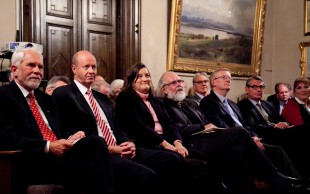
Årets Birkelandsforelesning vel gjennomført
20. september ble Birkelandforelesningen arrangert for 25. gang. Forelesningen ble holdt av professor Patricia Reiff fra Rice University, Department of Physics & Astronomy, Houston, Texas. Patricia Reiff er grunnlegger og direktør for Rice Space Institute og har vært involvert i plasmafysikkforskning i over 40 år, med nordlys og romvær som spesialfelt. Foreleseren fokuserte på utfordringen i å kartlegge og forutsi nordlys, og framskrittene innenfor feltet der hennes eget institutt, Rice Space Institute står sentralt i utviklingen av nye teknikker.
Akademiets preses, Nils Chr. Stenseth, ønsket velkommen til årets store Birkeland-markering. Arrangementet startet med foredraget "The Birkeland legacy - from academia to industry" som ble holdt av professor Truls Norby fra Kjemisk institutt ved Universitetet i Oslo.
Deretter var det utdeling av Yaras Birklandpris som i år gikk til den kinesiske forskeren Yun Cheng. Prisen på 100.000 kroner og et diplom ble overrakt av Yaras konsernsjef Jørgen Ole Haslestad.
Hele arrangementet foregikk på engelsk; se sammendrag av de to foredragene under.
The Birkeland legacy - from academia to industry
In a country with rich traditions and resources in fishing, shipping and mining, Kristian Birkeland - professor at University of Oslo - did something unusual and rare when he discovered and developed the process of combining nitrogen and oxygen in an electrical discharge, starting an entirely new industrial era. Only a century later was innovation of this kind manifested officially as one of the pillars and purposes of academic research in Norway. But neither innovation nor commercial success are easy or come by order, not least in Norway. But application of research does make the fundamental research better and our universities and professors are taking the first steps in this direction.
Birkeland Lecture:
Mapping and Predicting the Aurora - abstract
Simultaneous auroras over the northern and southern hemispheres, August 17, 2001.
Advances in understanding, mapping, and even predicting the aurora have made major strides in the past 25 years. From early work by Birkeland and even Benjamin Franklin, to rocket, radar, and spacecraft (particularly multiple spacecraft), we have learned more about the location, acceleration mechanisms, and mapping to the Earth's magnetotail.
With multiple spacecraft we have been able to show that the "inverted-V" type aurora is indeed caused by auroral acceleration by parallel electric fields, and that diffuse aurora is caused by pitch angle scattering of trapped electrons in the magnetotail.
In addition, "wave accelerated" auroras can also be observed near the boundary between open and closed magnetic fields. Advances in predicting the aurora go hand in hand with predicting geomagnetic activity indices such as Kp, AE, and Dst.
At Rice University we have developed algorithms based on a neural network using solar wind and Interplanetary Magnetic Field input that can predict Kp, AE and Dst 3 and even 6 hours ahead (http://mms.rice.edu/realtime/forecast.html), where users can sign up for a free email notification of events. In parallel, The Johns Hopkins University's Applied Physics Laboratory has an auroral prediction algorithm that can provide a georeferenced auroral map 45 minutes in advance. We hope to merge the two techniques in the near future, yielding an accurate georeferenced auroral prediction up to 3 hours in advance.
